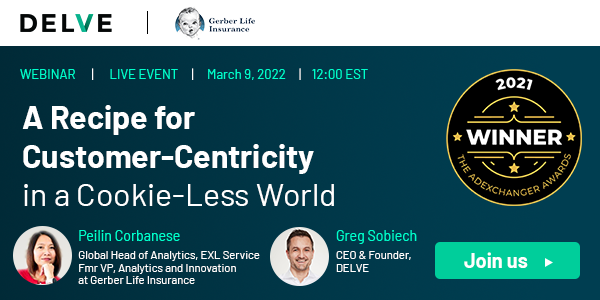By Greg Sobiech, CEO & Founder, DELVE
When first-party data became the center of every marketing conversation, every CMO I talk to started asking the same questions: How do I achieve return on marketing investment in a cookieless world? How do I navigate evolving data governance and privacy concerns and meet customer expectations for hyper-personalized experiences?
The drumbeat from the industry calls for big, bold change – “First-party data-driven marketing transformation – now!” But this prevailing narrative has too many marketing leaders starting from a reactive, scarcity mindset, trying to run before their marketing programs have started to crawl.
Here’s how CMOs can rethink their approach and get traction toward a customer-centric transformation by being both more strategic and more tactical.
If you don’t know where you want to go, you won’t get there
The deprecation of cookies has CMOs rushing to find tech-driven solutions to the first-party data challenge. But while tech certainly plays a key role in marketing transformation, it isn’t the starting point.
Instead, CMOs need to start with a strategic vision: What should my customer journey look like? To answer this question effectively, you need to think empathetically. Map out the current customer journey and consider all the barriers, sources of friction and pain points.
It’s helpful to think in terms of “swim lanes” in the customer journey. In one lane is the user experience – what the customer is actually doing (e.g., visiting your website, completing a form to get more information, placing an order). In another lane is your messaging – what you’re communicating to the customer at each step, in what way, and how that messaging naturally leads them to the next step.
The third lane is first-party data – what the customer is telling you at each step in the journey, including insights to their unique challenges, goals or preferences, as well as details around demographics and lifestyle. (Are they single or married? Do they have kids? Do they rent or own a home?)
The last lane is technology – the tools enabling UX, delivering messaging and capturing customer data. Marketing leaders don’t have to get into the technical weeds here, but they should be asking the right questions (e.g., “Do these tools talk to each other?”). The answers they get should make sense.
Focus on the fundamentals: crawl, walk, run
Once it’s time to get tactical, where do you start?
Companies make the mistake of trying to change all at once, jumping right to a major project with a shiny goal in mind, like building their own customer data platform. But in our transformation projects with marketers, we almost always find they’re missing simple opportunities.
Their programmatic marketing isn’t optimized. Often, they have multiple platforms bidding on the same audience. They’re not doing testing on paid search programs. Or their web pixels don’t always fire correctly. It’s much easier to talk about the big, sexy customer data platform than to acknowledge the simpler things you’re not doing well today. But these are all things you need to fix before you can look bigger. It’s like taking a Ferrari in for a tune-up when the tires are still flat.
Shoring up the fundamentals builds a foundation of data clarity and data hygiene – which ensures you don’t end up putting bad gas into your customer data platform (or your Ferrari). Even more importantly, these quick wins give you momentum and buy-in to power the bigger steps in your marketing transformation.
A real-world example of strategic thinking and a simple start
With DELVE, Gerber Life Insurance Company (GLIC) recently captured and integrated more than three billion first-party data records into a cloud-based data lake in Google Cloud Platform – all in less than 12 months. That’s the kind of big, shiny project that marketing leaders want to achieve – and it won AdExchanger’s Best First-Party Data Strategy Award for 2021.
But GLIC had been slowly building up to this project for years. They started by thinking strategically about the experience they wanted to create for customers. Then they got tactical, focusing on the fundamentals, quick wins and building momentum.
It’s not ground-breaking, but it’s a simple, repeatable formula for driving meaningful change and creating real market advantage with your first-party data.














